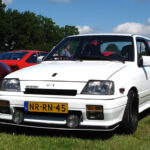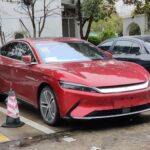Suzuki Swace Review: A Full Hybrid Wagon That Makes Sense
Introduction
Suzuki is stepping into the hybrid arena with full force, expanding its range with the Suzuki Swace. In collaboration with Toyota, Suzuki has created this compact estate, borrowing much of its design and engineering from the Toyota Corolla Sports Tourer. As a result, the Swace brings a solid hybrid option to Suzuki’s lineup, offering practicality and efficiency. But is the Swace compelling enough to win over new customers? Let’s dive into the details and see what this hybrid wagon has to offer.
The Origins of the Suzuki Swace
When is a Suzuki not exactly a Suzuki? The answer is: when it’s a Swace. The Swace is essentially a rebadged version of the Toyota Corolla Sports Tourer, an efficient hybrid estate with a self-charging engine. Suzuki’s partnership with Toyota has allowed them to quickly expand their electrified offerings, helping the brand meet European emissions regulations. Aside from a few subtle cosmetic tweaks, the Swace is almost identical to the Corolla.
This partnership has given Suzuki an entry back into the compact estate segment, which the company has been absent from since the days of the Baleno estate. With the Swace, Suzuki is targeting customers who value both hybrid efficiency and the practicality of an estate.
Hybrid Powertrain and Performance
The Swace combines a 1.8-liter 102-horsepower engine with a 53 kW electric motor, delivering power through a CVT gearbox. While the performance is not exhilarating, it’s more than adequate for daily driving. The 0 to 62 mph sprint takes 11.1 seconds, and the top speed is capped at 111 mph.
What stands out is the car’s seamless hybrid experience, offering three driving modes: Normal, Eco, and Sport. The driver can also engage EV mode, which allows the car to run on pure electric power for short distances, making it ideal for city driving and situations where noise and emissions need to be minimized. While the EV mode won’t cover vast distances, it’s perfect for reducing emissions in congested areas or early morning starts.
Each driving mode adjusts the vehicle’s dynamics to prioritize fuel economy or performance. Eco mode enhances efficiency by limiting throttle response and even adjusting air conditioning output, while Sport mode sharpens throttle response for more spirited driving.
A Familiar Design with Minor Tweaks
In terms of design, the Swace mirrors the Toyota Corolla Sports Tourer almost exactly, with only a few key differences. The front fascia features a unique Suzuki grille and LED headlamps, while the rest of the car sticks closely to its Toyota counterpart. Even the hybrid badges on the car are Toyota-sourced, leaving little room for distinction between the two models.
Despite the limited differentiation, the Swace is a sharp-looking vehicle. The sleek profile is emphasized by a dynamic crease running from the front wheel arch to the rear, giving the car a streamlined and modern appearance. Standard 16-inch alloy wheels add a touch of style, while the rear features LED taillights and a clean design, complemented by a subtle roof spoiler.
Interior Comfort and Technology
Step inside the Swace, and you’ll find a cabin that feels both familiar and well-appointed. The interior shares many elements with the Corolla, including Suzuki branding on the instrument cluster and the central 8-inch touchscreen display. This system handles the usual infotainment features, including DAB radio, Bluetooth, Apple CarPlay, and Android Auto. Although the interface isn’t the most graphically sophisticated, it is functional, and the standard rearview camera is a welcome addition.
The interior materials, such as soft-touch plastics and chrome accents, give the cabin an upscale feel. The dashboard features a combination of digital and analog elements, providing a clear and user-friendly driving experience. Suzuki has added its own touches to make the interior more appealing, such as a leather-stitched steering wheel and piano-black trim around the center console.
Practicality: Cargo and Rear Seat Space
Practicality is a major selling point for the Swace, and its 596-liter boot space is competitive within its class. While the rear seats may feel a bit tight for taller passengers, the boot offers plenty of room for everyday needs. Under the floor, additional space is available, although Suzuki has chosen not to offer a spare wheel. Folding the rear seats down expands the cargo space to 1,606 liters, making the Swace a versatile choice for families or those needing extra room for longer trips.
The rear seats, though slightly limited in leg and headroom, offer a few amenities. There’s a center armrest with cupholders, overhead reading lights, and coat hooks. However, the lack of rear USB ports and only one seatback pocket is a minor drawback for passengers.
Pricing and Competitors
The Suzuki Swace is priced competitively, with the entry-level SZ-T trim starting at around £27,500, while the higher-spec SZ5 costs about £1,800 more. At first glance, these prices may seem a bit steep, but when you factor in the full hybrid technology and the generous level of standard equipment, it becomes more reasonable. Many dealers are also offering discounts, making the Swace even more appealing.
The Swace faces competition from a variety of rivals, including estate versions of the Ford Focus, Volkswagen Golf, SEAT Leon, and Skoda Octavia, all of which offer mild hybrid options. However, the Swace’s full hybrid system gives it a significant edge in terms of fuel efficiency and emissions. Other competitors, like the Kia Ceed Sportswagon, offer plug-in hybrid options with more electric-only range, but at a higher price point.
Efficiency and Running Costs
One of the Swace’s biggest strengths is its fuel economy. The hybrid system delivers up to 64.2 mpg on the combined cycle, with CO2 emissions of just 99 g/km. These impressive figures make the Swace an excellent choice for eco-conscious drivers, especially in urban areas where its hybrid system shines.
To help drivers maximize efficiency, the car offers an Eco drive mode that adjusts throttle response and air conditioning output to save fuel. The hybrid system also regenerates energy during braking, storing it in the battery for later use. Clever features like the S-Flow control for the air conditioning, which detects the number of occupants and adjusts the climate system accordingly, further enhance energy savings.
Conclusion: A Practical, Eco-Friendly Choice
Suzuki’s decision to collaborate with Toyota on the Swace was a smart move. By using Toyota’s proven hybrid technology, Suzuki has brought a full hybrid estate to market quickly and at an affordable price. While the Swace may not offer the same level of differentiation as other rebadged models, its combination of practicality, efficiency, and hybrid power makes it an appealing choice for those looking for an eco-friendly estate.
I found someone who shared a similar experience with the Swace, and I was inspired by their insights. If you’re curious to see more, check out this video: Suzuki Swace 2021 – FULL REVIEW.






